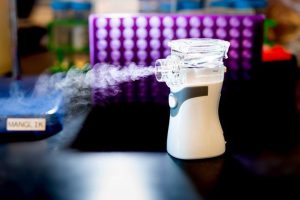Nanobodies Providing Protection Against the Coronavirus
A recent study, now available on the preprint server bioRxiv from a team of researchers at the University of California San Francisco, features an innovative approach to stopping the spread of SARS-CoV-2, the virus behind the COVID-19 pandemic. The team has developed a synthetic aerosol nasal spray – which they termed “AeroNabs” – that works to inhibit the viral entry into human cells.
This news is extremely exciting as it aims to tackle the transmission of the coronavirus disease. We were also pleased to see that a Yeast-Display Nanobody Library available via Kerafast was used to identify the most promising nanobodies. The library was developed by the Andrew C. Kruse lab at Harvard University and made available to the broader research community in our catalog.

Due to the inherent stability of nanobodies, there was no loss of antiviral potency in the aerosolized form, suggesting that AeroNabs are a potent SARS-CoV-2 antiviral that could be practical to administer via a shelf-stable inhaler or nasal spray. Photo Credit: Noah Berger
Why Nanobodies?
Nanobodies are antibody-like immune proteins that naturally occur in llamas, camels, and other similar animals. It is proposed by senior study author Aashish Manglik that nanobodies offer several unique benefits that are especially desired while engineering therapeutics against SARS-CoV-2.
Nanobodies are smaller than human antibodies, making them easier to modify in the lab and much more stable. In addition, scientists can utilize standard biotechnology methods to produce nanobodies, allowing them to be mass-produced easily and inexpensively.
While working with such nanobodies, the team began to improve upon them through protein engineering, which led to the creation of AeroNabs.
Disabling Spikes and Preventing Infection
SARS-CoV-2 relies on its spike proteins to enter and infect cells. The research team wanted to find nanobodies that prevent spike interactions with host cells, hence preventing the virus from infecting human cells.
The scientists tested more than two billion synthetic nanobodies using Dr. Kruse’s Yeast-Display Nanobody Library, and ended up with 21 nanobodies that successfully prevented the spike protein from interacting with host cell receptor ACE2. Further tests with the three most promising nanobodies uncovered one specific nanobody that was extremely effective in preventing infection.
Developmentof ‘AeroNabs’
The researchers then engineered that one nanobody to further increase its efficacy against the COVID-19 disease. In particular, they linked three nanobodies together to form a trivalent nanobody 200,000 times more powerful than a single nanobody by itself.
Then, after a series of tests that exposed the nanobody triplets to high temperatures, the researchers were able to convert them into a dry-powdered form, eventually leading to an aerosol formulation. These aerosolized nanobodies could potentially be administered through an inhaler or nasal spray. The researchers hope their AeroNabs could be an important line of defense against COVID-19, especially for those who cannot access or respond to SARS-CoV-2 vaccines.
As AeroNabs co-inventor Peter Walter said, “Far more effective than wearable forms of personal protective equipment, we think of AeroNabs as a molecular form of PPE that could serve as an important stopgap until vaccines provide a more permanent solution to COVID-19.”
For more information about the study, check out this Science Translational Medicine blog post.
Related Research Tools
If you work in this area of research, the Yeast-Display Nanobody Library is available to researchers via our catalog. You also might be interested in our full collection of reagents for coronavirus research, including recombinant spike glycoprotein antibodies and the Delta-G-VSV Pseudotyping System, a reverse genetics system that enables studies of SARS-CoV-2 viral entry and COVID-19 vaccine effectiveness.
In addition, our sister company Absolute Antibody recently began offering SARS-CoV-2 synthetic nanobodies through a partnership with University of Zurich. Antibody engineering was used to fuse the nanobodies to Fc domains in different species, isotypes and subtypes. The original nanobodies and newly engineered formats can be used as serological controls in COVID-19 diagnostic tests as well as in research and therapeutic development.


